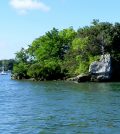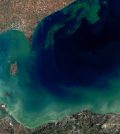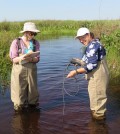Posts for tag "Ohio State University"
When Green Isn’t Good: Cyanobacterial Toxin Knowledge and Toxicity Forecast High on Stone Lab’s List of Research Pursuits
Ohio State’s Stone Lab researchers make headway in understanding Microcystis toxin production and predicting toxicity of HAB events in the Lake Erie region.
- Posted October 25, 2018
Cellular Data Buoy Supports Lake Erie Algae Research, Public Outreach
Researchers at Ohio State University’s Stone Lab gather algae measurements using a cellular data buoy with the goal of one day predicting bloom toxicity.
- Posted November 17, 2016
Ohio Sea Grant Research Roundup
What we learned about Ohio Sea Grant research during a summer 2016 trip to Ohio State University’s Stone Laboratory, plus a few projects we didn’t cover.
- Posted October 4, 2016
Lake Erie Watersnake: A Look At The Comeback
The Lake Erie watersnake was once endangered in Ohio and threatened federally. But thanks to a nearly decade-long effort, the snake is thriving once again.
- Posted September 8, 2016
Q&A With Ohio Sea Grant’s Chris Winslow
In a Q&A, Ohio Sea Grant’s Chris Winslow shares updates on some ongoing projects at the fore of improving water quality in and around Lake Erie.
- Posted September 2, 2016
Scientists Document Groundwater And Seawater Mixing On US Coasts
Ohio State and NASA researchers have developed a map of underground drainage systems that connect fresh groundwater and seawater.
- Posted September 2, 2016
Possible Costs For Fixing Lake Erie Algal Blooms
An agricultural economist lays out different options for fixing Lake Erie’s algal blooms, like a phosphorus tax or subsidy, along with associated costs.
- Posted September 1, 2016
Lake Erie Food Web: What Are Cyanobacteria Bloom Effects?
Investigators from Ohio State University’s Aquatic Ecology Laboratory evaluate effects of cyanobacteria blooms on the Lake Erie food web.
- Posted August 31, 2016
Solving Western Lake Erie Nutrient Problems Is Daunting But Possible
A modeling effort led in part by Ohio State scientists shows that the western Lake Erie phosphorus reduction target can be met with more farmers onboard.
- Posted August 30, 2016
Clean Energy In Ohio On The Rise
An update on the growing use of clean energy in Ohio, marked by a recent surge in solar and a steady decline in the use of coal burning.
- Posted August 24, 2016
Importance Of Water To Life: Ohio State Study Sheds Light
Using tryptophan, DNA polymerase and high-speed lasers, Ohio State researchers study the importance of water to life.
- Posted August 1, 2016
Ohio State Data Buoy Captures Lake Erie’s Real-Time Conditions
A research buoy operated by Ohio State University’s Stone Lab is deployed in Lake Erie and keeping an eye on water quality around Put-in-Bay, Ohio. Data from the platform are available online in real time. Some of...
- Posted May 19, 2016
Ocean Carbon Flux Dissected With Genetics Techniques
The Tara Oceans Expedition provided data allowing Ohio State scientists to discover which bacteria and viruses have significant roles in ocean carbon flux.
- Posted March 15, 2016
Models Predict HAB Events In Lake Erie Could Double In Next Century
Climate change, phosphorus buildup and healthy algae populations are some of the ingredients which could lead to a doubling of harmful algal blooms in Lake Erie in the next century, according to a release from Ohio State...
- Posted December 23, 2015
Coral With Higher Fat Reserves More Likely To Survive Bleaching
As temperatures increase and bleaching events are on the rise, researchers are attempting to determine what coral characteristics might help the sensitive animals survive in warmer oceans. According to a release from Ohio State University, a coral’s...
- Posted December 4, 2015
Ohio State, U. Hawaii Scientists Test Ability Of Corals To Adapt To Acidification
Scientists at Ohio State and U. Hawaii test the hypothesis that corals can adapt to ocean acidification conditions and warmer water temperatures.
- Posted September 23, 2015
Uganda Sampling, Lab Analysis Help Ohio State Scientists Study African Cichlids
Ohio State scientists study how African cichlids respond to environmental changes by sampling streams in Uganda and conducting research in their lab.
- Posted August 2, 2015
Ohio regulators still working to understand algal toxicity
Ohio regulators are still in the early stages of understanding how to keep the public safe from algal toxins.
- Posted September 11, 2013
Q&A with Justin Chaffin: Taking samples and advising students on Lake Erie
You can find Ohio Sea Grant’s Stone Laboratory research coordinator Justin Chaffin sampling Lake Erie and working with students.
- Posted September 6, 2013
Another record Lake Erie algal bloom possible; study cites solutions
A study of Lake Erie's recent record bloom finds the causes are likely to repeat, but an attainable cut in nutrient loading could help.
- Posted April 25, 2013





















